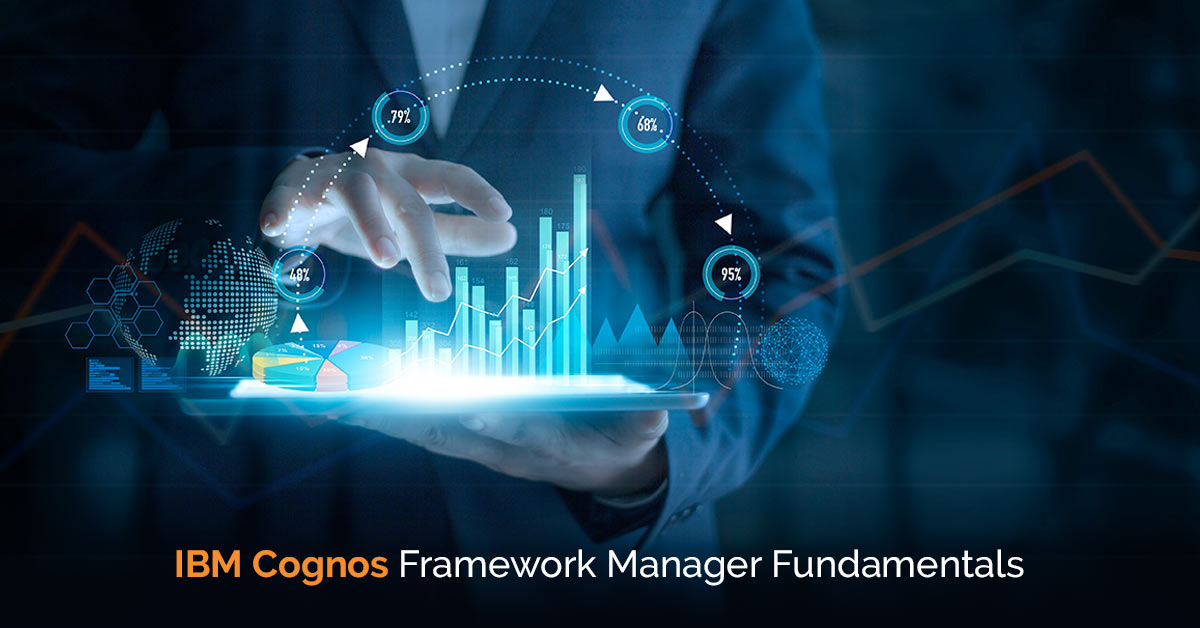
IBM Cognos Framework Manager Fundamentals
IBM Cognos Framework Manager is a metadata modeling tool for IBM Cognos Analytics. A model is the collection of metadata, including business and physical information for one or more data sources. The Cognos Framework Manager issues the business model in package form for Cognos BI for analysis.
Before starting any project in Framework Manager, it is crucial to analyze BI reporting demands. This support you in discovering metadata, data strategies, and report package delivery. This helps you identify what data sources the Cognos Framework Manager needs to acquire the required information to generate a BI report.
Factors to consider before starting a new project:
- Data sources required to meet BI demands
- Types of the data warehouse system
- Data refresh in the data warehouse
- BI reporting, which is either monthly, weekly, or daily
What is a Metadata Model?
A metadata model refers to the collection of metadata from a database. It includes all the entities of a database, like columns, rows, relationships, and tables. In IBM Cognos BI tool, the metadata is transferred in packages to produce appropriate SQL commands to the database to execute the reports.
Metadata Workflow
In a few scenarios, the metadata is transformed in Cognos Framework Manager to meet presentation and reporting demands to ensure predictable outcomes. The model enables users to hide the complex structure of underlying data sources. Hence, offering them more control over the data. You can organize data and select which entities or data must be displayed for users. The main objective of modeling the metadata is to design a model which offers accurate, predictable outcomes.
Insight into Layers of Cognos Framework Manager Model
The Framework Model includes three layers. Each of these layers is in a separate namespace. This includes:
- Database layer: The database, known as the physical layer, includes a database query subject for every table in the physical data model. It also contains alias shortcuts acting like a copy of the original object with independent behavior.
- Logical layer: This contains query subjects that bring data from the database query attribute and represent them more wholesomely.
- Dimensional layer: It contains the measure dimensions and hierarchies for publication to a package. Each size in the logical layer has an extent in the dimensional layer with one or more scales explained. They commonly contain the caption field twice, once as an attribute and once as a caption for the level that can be applied in report filters.
IBM Cognos Framework Manager User Interface (UI)
There are several components of the user interface, as mentioned below:
- Project viewer: This panel is present on the left side of the window and enables users to access all the current projects. It looks like a tree.
- Project info: It is present in the center panel and is used to handle objects of the existing project. It includes three tabs, namely diagram, dimension, and explorer.
- Properties: It lies at the bottom of the interface and determines the value for several attributes of an object.
- Tools: It is present on the right side of the panel and offers access to significant tools. Options like displaying an object and its dependents, changing project language, searching, and others are available under the tools component of the user interface.
Reporting Objects
IBM Cognos Framework Manager UI has various objects you interact with in project info panes. The following sections show query objects in the project viewer panel that includes reporting entities:
- Data source object: Incorporates data to a corresponding object in the data source and utilizes a modified SQL statement to restore data.
- Model object: Incorporates data into current metadata in the model.
- Stored procedure: It is practiced executing the database stored processes to retrieve data.
- Query item: It lies under a query subject. Incorporates data to the adjacent object underlying the data source.
- Regular dimension: It is descriptive and includes the highest level of granularity.
- Measure dimension object: It refers to a collection of OLAP queries.
Insight into Cognos Framework Manager
IBM Cognos tool allows performance management on average or modified relational data sources and a broad range of OLAP data sources. When you bring multilingual and security abilities, one model can provide the ad hoc querying, reporting, and analysis requirements of several groups of users worldwide.
Working with Cognos Framework Manager
Before starting work in IBM Cognos Framework Manager, users should deeply understand the reporting issue they wish to resolve. To begin with, follow the steps mentioned below
- Analyzing the problem: First, you should know the reporting issue you are trying to resolve and what data is present to solve it.
- Creating IBM Cognos Analytics applications: Here, you apply the IBM Cognos Analytics elements to develop reporting and analysis applications.
- Learn about the objects you will use: When you are functioning with IBM Cognos Framework Manager, you work with several things in a project.
- Creating a project: You work in relation to a project in Cognos Framework Manager. The project includes objects that you arrange for your users per an organization’s business rules and model. You can view such things on the project page.
- Opening a project: Before importing or changing current metadata, you should open a project.
- The project page: Once you open or create a project, the project page displays. It is where you publish, package, and design project metadata. It includes various views and panes that users use to modify and view the objects in a project.
- Naming conventions for objects in a project: In a project, all things have a unique identifier. The reference includes one or more sections based on the type of object. This section consists of a location in the project hierarchy and an object name as explained in the default language of the project.
- Sample models: Every user can explore Various sample models with IBM Cognos Framework Manager. The guidelines for modeling metadata are used to create sample models.
Bottom Line
IBM Cognos Framework Manager is the best software to acquire metadata. Metadata act as a significant source for generating reports and performing analysis.


More on Technology
Innominds and Qualcomm Collaborate to Drive Enterprise Digital Transformation with High-Compute Edge AI Platform
-
Team Eela



